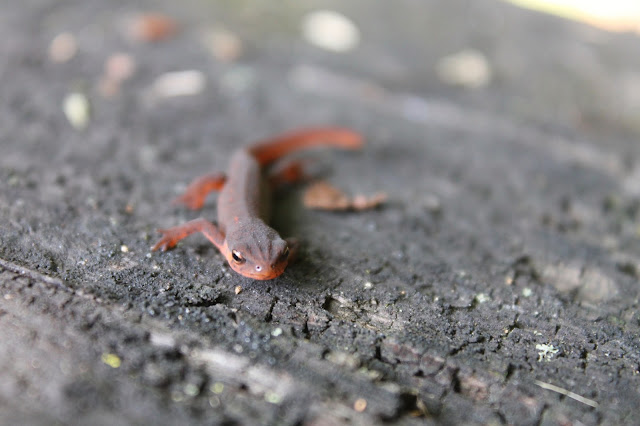- La Cépède, early French naturalist, 1802
Me and toads go way back. Toads were some of the first amphibians I came into contact with, and due to their relatively indifferent demeanor, some of the first I caught and kept as pets as a very young child. I found toads to be extremely fascinating creatures. The way they sat with that pugnacious look on their faces, the way they grudgingly hopped about when provoked, they way they lit up when offered bugs to eat, and the way they felt - that dry, bumpy skin covered in "warts". Throughout my childhood I would catch toads, keep them for awhile, admire their nature, and then release them where I found them. I even raised toad spawn - long, slimy strings of eggs coated in clear jelly - into tadpoles and then into toadlets. Even though I have worked with so many exotic species over the years, my appreciation for the American toad, Bufo (Anaxyrus) americanus, have never waned.
This is why I have been concerned for awhile now about the status of these toads in the Chicago area. Once fairly abundant, these animals have been very hard to find lately. Their secretive nature doesn't help my case, but I know where toads are, I know their life cycle well and I know their habitat, and it seems the places I have been able to find them in in the past are devoid of them. Most of the time, when I'm out hiking or field herping, I spend some time looking for toads even when that's not my goal. It concerned me that I haven't seen a toad in the wild since probably the last time I posted a photo of one here (2011?). What's going on with the toads? Is it simply bad luck on my part, or are there environmental impacts affecting them?
The rapid decrease in the number of various semi-aquatic frog species (i.e. Rana sp.)in the Chicago area is duly noted. I haven't seen sustainable populations of green, leopard, or pickerel frogs in a while but I blame tainted runoff and other anthropogenic factors affecting water among the top culprits. Bullfrogs seem to thrive in spite of raw sewage and low oxygen; they are omnipresent. But toads spend much less time in the water than the true frogs. I tend to believe that the animals are struggling in their larval stage - the only time they spend their lives completely underwater. Due to the soaring bullfrog population, predation of the toad larvae by the voracious frogs is also likely. I hope that my failure to find toads is due to bad luck or oversight. I will continue to monitor the areas that have historically supported toads with the hopes that my notion that toads are disappearing is wrong.
With all this in mind, I am happy to report that while searching specifically for toads today, I found one. Joined by my nephew Jeffrey (Peffers), and on a tip provided by him, a toad presented itself to us on the edge of a path alongside a creek in suburban DuPage County. It was healthy, bright-eyed and alert - a sight for sore eyes for certain.
Garter snake habitat
We ended up finding a number of garter snakes today, most we simply let crawl on their way as we trekked onward in our search for northern redbelly snakes. We moved to a preserve in suburban Cook County where I know redbellies can be found. We ended up at the "newt swamp", a large swamp I've been to before, and I thought I'd take a crack at finding a newt for Jeffrey to see for the first time. I lifted a number of logs at the edge of the swap to no avail, finding plenty of worms, slugs, centipedes, beetles, and spiders, but no newts. Now mind you, seldom do I show concern over my own well-being when looking for herps in this area. There are no venomous species, and I have never hesitated lifting logs or other discarded items. So this is why, when I lifted "that" log, I was surprised to find that I had disturbed a very active hornet nest. In a split second I went from "Oh, crap.." to literally running away at full speed as far away as I could get from that hive, as we were being chased by a swarm of very defensive stinging insects. Fortunately, Jeffrey was well ahead of me per my direct order, but I took the brunt of the hornets' angst, being stung a couple times. The sting on my hand occurred immediately after I lifted the log that shielded the nest.
Three hours later, from my cell phone.
We ultimately found a redbelly snake (Storeria occipitomaculata) at this preserve, but unfortunately it had recently met its end via an automobile on the access road.
We also did find a central newt eft (Notophthalmus viridescens louisianensis), and luckily it was alive and well. It was very tiny and difficult to photograph - I still need to work on getting that macro lens.
A few more photos from the day.
Gypsy moth larva - unfortunately quite of few of these were seen.
Wetland habitat
Jeffrey is on top of the world!













No comments:
Post a Comment